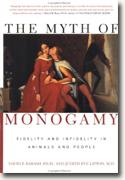The Myth of Monogamy
David P. Barash & Judith Eve Lipton
book reviews:
· general fiction
· chick lit/romance
· sci-fi/fantasy
· graphic novels
· nonfiction
· audio books
· author interviews
· children's books @
curledupkids.com
· DVD reviews @
curledupdvd.com
newsletter
win books
buy online
links
home
for authors
& publishers
for reviewers

 |
The Myth of Monogamy: Fidelity and Infidelity in Animals and People David P. Barash & Judith Eve Lipton Owl Books Paperback 240 pages May 2002 |
|
The authors of The Myth of Monogamy want us to know more about sex than our mothers, daddies, preachers and sex education teachers were willing to tell us. Remember the old song, "Birds do it, bees do it, even educated fleas do it?" Well, thanks to Barash and Lipton (he has a degree in zoology and is a professor of psychology, she is a psychiatrist who specializes in women's concerns), we now know that yellowhammers, bluetits, and red deer do it -- and how -- and we realize that they are no less motivated than we by factors like the presence of lots of males near a single female, or the attraction of a female to a male (or series of males!) who can mate longer, who try harder.
Sex, it seems, is about producing good offspring: chicks or chimps off the old block who are symmetrical, colorful, powerful, and most likely to produce viable and powerful progeny in turn. The trick is to find the mate best suited to that task and get at him or her before anyone else does. Did you know that, at a nightclub, women "wear tighter clothing, and less of it" if they are in the fertile part of their cycle? Human females are blessed (or cursed) with "concealed ovulation" - this keeps them from being jumped on periodically by lots of males aware of their cycle, and prevents men from spending most of their time jumping (or does it?). Thus women are, biologically speaking, far more able to exert control over the mating process, even though their biology is telling them to mate when fertility is highest (emitting subtle messages leading to those all too frequent "sexual encounters when they are more likely to conceive"). By the logic of the old brain, this is a Good Thing. The hydra-headed monster of sexual jealousy, suggest the authors, "is a give-away. Its widespread existence suggests that...episodes of infidelity...have long been an important part of the human evolutionary past." When a male big horn sheep, for example, is with a ready female, his approaches will be slow and gentle" - until he is surrounded by rival males. Suddenly he becomes "more aggressive and brusque...A male hamadryas baboon uses coercion to keep his small harem of females away from other males." As observed by Jane Goodall, a male chimp uses brutal tactics to herd a female away from the pack - and as the isolation from other males increases, he relaxes and she becomes more docile - "the obvious human parallels are worrisome." The authors draw a line to marital abuse which is logical enough, and troubling. The book is salted with many such examples comparing animal behavior and our own sometimes ridiculous antics in pursuit of what we like to call love but which may be, frankly, just a good time. Though our Judeo-Christian tradition is in denial on the subject, most of us would do, or would like to do, what comes naturally once in a while, even outside the bond of marriage - what Barash and Lipton call EPCs: extra-pair copulations. "The evidence is ...overwhelming that many people are capable not only of 'making love to' but also of loving more than one person at the same time. But we are socially prohibited from doing either." On the assumption, intuitive or grandly rationalized, that we can change our lives, produce more successful liíl nippers, or just have a better time on our poorly lighted way to a dusty death, we may leap the bounds of social prohibition - and take some of the direr consequences: children sired but un-fathered, disease possibly fatal, social disgrace, untrammeled guilt. As the authors comment, monogamy is, like Churchill's democracy, "the worst possible system, except when you consider the alternatives." Rich with scientific facts which should delight the animal lover, perhaps telling the layman more than he wished he knew about the private lives of flies and worms, the authors (who proclaim their own marriage of more than twenty years, and two wonderful children) draw from a multitude of disciplines including some rather cheeky classical poetry. They admit having consulted their fifteen-year-old daughter for "slang". The book moves along happily, with more than a dollop of wit to dilute some of the ponderous scientific segments. Posing such profound questions as "What is a penis for?" ("ask a young boy and you get an unequivocal answer - peeing"), it provides answers that are far-reaching, well-researched, and often refreshing. We are left with a lot to laugh about and much to ponder.
|
|
|
|
 Click here to learn more about this month's sponsor! |
|
| fiction · sf/f · comic books · nonfiction · audio newsletter · free book contest · buy books online review index · links · · authors & publishers reviewers |
|
| site by ELBO Computing Resources, Inc. | |
 It's all biology - or is it? This question seems to be at the heart of the book.
It's all biology - or is it? This question seems to be at the heart of the book.